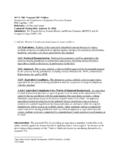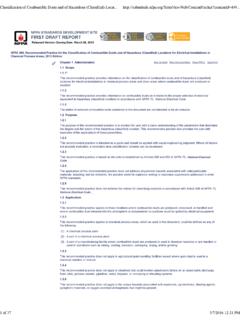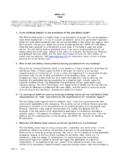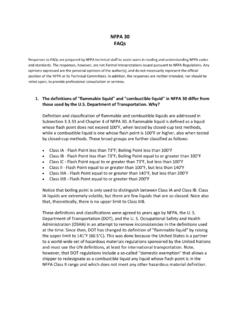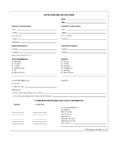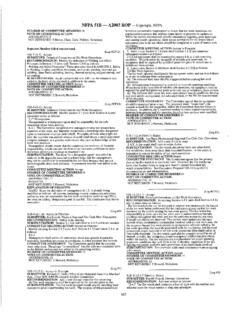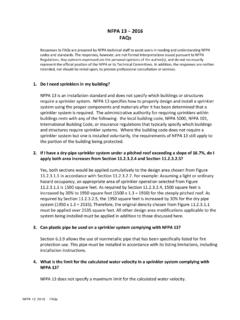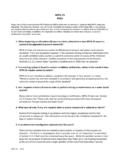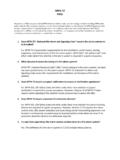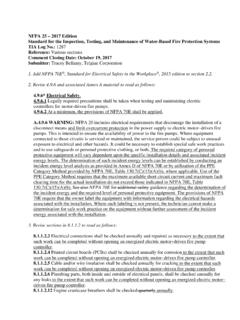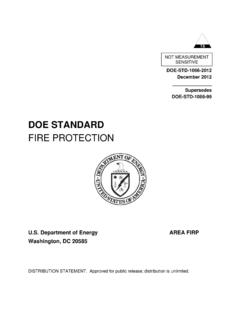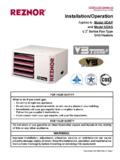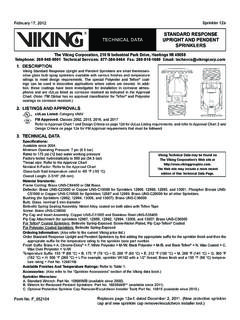Transcription of 2014 Style Manual - NFPA
1 2015. NATIONAL ELECTRICAL CODE . Style Manual . 1. FOREWORD. August 2015. The National Electrical Code is used nationally and internationally as the basis for safeguarding persons, buildings, and their contents from hazards arising from the use of electricity. It is vitally important that the text be as explicit as possible and that maximum consistency be achieved in the language used in the text. The Code contains those provisions considered necessary for safety and thus is widely used as a basis for legal enforcement in the installation of electrical conductors and equipment in buildings and certain other premises (as detailed in the Code itself); this places a major responsibility on those involved in the preparation of the document to use forms of expression that promote uniform interpretation.
2 The National Electrical Code Correlating Committee has recognized these responsibilities and has issued this Manual . Preparation and Date of Adoption. This Manual was originally prepared by the Editorial Task Group of the National Electrical Code Committee and adopted by the National Electrical Code Correlating Committee on May 13, 1969. It was amended September 22, 1975, October 11, 1984, October 12, 1989, and May 9, 1994. In January 1999, the Correlating Committee Task Group on the Usability of the NEC rewrote the Manual . It was adopted by the Correlating Committee on March 19, 1999 and by the Standards Council on April 15, 1999.
3 It was amended March 1, 2001, January 15, 2003, and August 9, 2011, August 2015. Valuable guidance in the preparation of this Manual was provided by several members of the Correlating Committee. 2. TABLE OF CONTENTS. Foreword 2. Chapter 1 General 4. Purpose 4. Scope 4. Regulatory Adoption 4. Examples 4. Chapter 2 Document Structure and Numbering 5. Subdivisions of the NEC 5. Content of NEC 8. Tables and 9. Numbering 10. General References to Other Articles .. 11. Exceptions 12. Chapter 3 Editorial Guidelines 13. Mandatory Rules, Permissive Rules, and Explanatory Information 13. Word Choices 15.
4 Writing Style 18. Chapter 4 References and Extracts 22. References to Other NEC Rules 22. References to Other Standards 22. Extracts 23. Chapter 5 Editorial Administrative Responsibilities 24. General 24. Responsibilities of Committee Members 24. Responsibilities of nfpa Staff 24. Annex A Editorial Guidance on Exceptions 25. Annex B Standard Terms 27. Annex C Conversion Reference Table 37. Index 40. 3. NATIONAL ELECTRICAL CODE (NEC ). Style Manual . CHAPTER 1 GENERAL. Purpose. The National Electrical Code (NEC) Style Manual is prepared under the guidance of the NEC Correlating Committee and is used to advise members of the Code-Making Panels on the required editorial Style and arrangement of the NEC.
5 It is intended to be used as a practical working tool to assist in making the NEC as clear, usable, and unambiguous as possible. Scope. This Manual provides editorial and administrative requirements for writing the National Electrical Code ( nfpa 70 ) and the Standard for Electrical Safety in the Workplace ( nfpa 70E ). Except as otherwise specified in this Manual , the NEC and the Standard for Electrical Safety in the Workplace shall comply with the Manual of Style for nfpa Technical Committee Documents. Requirements Not Included. The NEC Style Manual does not include many purely editorial and stylistic matters, including, but not limited to, the formatting of tables, capitalization practices, use of hyphens, and units of measurement.
6 For information on these editorial guidelines, see the Manual of Style for nfpa Technical Committee Documents. Format. The NEC is formatted differently from other nfpa standards. Examples of these differences include, but are not limited to, arrangement of the document, its internal numbering system, and use of informational notes. The Secretary of the NEC Correlating Committee shall be responsible for recommending to the NEC Correlating Committee resolutions of any apparent conflicts or discrepancies between the Manual of Style for nfpa Technical Committee Documents and this Manual . Regulatory Adoption.
7 Because the National Electrical Code is intended to be suitable for adoption as a regulatory document, it is important that it contain clearly stated mandatory requirements in the Code text. This should encourage uniform adoption of the National Electrical Code without alterations. Examples. The examples shown throughout this Manual are intended to be representative of the Style and arrangement of the text. The actual text used in the example may or may not match the current document text. 4. CHAPTER 2 DOCUMENT STRUCTURE AND NUMBERING. Subdivisions of the NEC. The National Electrical Code shall be organized as follows.
8 Introduction. Article 90 contains the scope of the NEC and administrative provisions. Chapters. Chapters are major subdivisions of the NEC that cover broad areas and are divided into articles. Chapters shall be organized as follows: Chapter 1 General Article 100 Definitions Article 110 Requirements for Electrical Installations Chapter 2 Wiring and Protection Articles 200 299. Chapter 3 Wiring Methods and Materials Articles 300 399. Chapter 4 Equipment for General Use Articles 400 499. Chapter 5 Special Occupancies Articles 500 599. Chapter 6 Special Equipment Articles 600 699. Chapter 7 Special Conditions Articles 700 799.
9 Chapter 8 Communications Systems Articles 800 899. Chapter 9 Tables Articles. Articles are chapter subdivisions that cover a specific subject such as grounding and bonding, overcurrent protection, luminaires, and so on. Each article shall have a title. Articles are divided into sections and sometimes into parts. 5. Parts. If an article is sufficiently large, or where necessary to logically group requirements, it shall be permitted to be subdivided into parts that correspond to logical groupings of information. Parts shall have titles and shall be designated by Roman numerals. (See example.) Parts typically consist of a number of sections; see for section numbering in articles that are subdivided into parts.
10 Example: I. Installation II. Construction Specifications III. Grounding Subdividing Sections. Sections shall be permitted to be subdivided for clarity, with each subdivision representing either a rule or a part of a rule. Up to three levels of subdivisions shall be permitted, and any level shall be permitted to contain a list. List Formats. Lists are a method of structuring the items necessary to complete a rule. Lists in any subdivision level or exception shall be numbered, and listed items shall be single words, phrases, or sentences. Items in a list shall not contain titles. Subdivision Titles.
